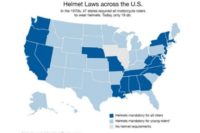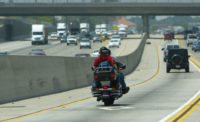Booming sales of novelty helmets boost toll of motorcycle deaths
A FairWarning report






Posted with permission from FairWarning.org:
The results were tragic but not surprising last May when Suzanne Randa and her fiance, Thomas Donohoe, crashed while riding Donohoe’s Harley Davidson on Highway 79 near the Southern California city of Loma Linda.
Donohoe, who was wearing a helmet meeting federal safety standards, escaped injury and walked away from the accident. Randa, 49, who wore a so-called novelty helmet that was cheap and stylish but offered no real protection, died at the scene after the strap broke and her head slammed onto the pavement.
“I just don’t think these helmets should be permitted,” said Randa’s 23-year-old daughter, Kelli Meador, who still has her mother’s scarred turtle-shell headgear.
Even as more than 800,000 novelty helmets are sold in the U.S. every year, and as motorcycle crash deaths mount, federal regulators have never acted with urgency to crack down on the popular but flawed headgear. Proposals to limit sales of the novelty helmets have been delayed over and over again.
False sense of security
It’s not because the National Highway Traffic Safety Administration (NHTSA) which sets safety standards for helmets, is ignorant of the problem. Six years ago NHTSA hired an independent lab to study seven novelty models, and found they all shared a distinguishing characteristic: they were worthless in a crash.
“All analyses gave a 100-percent probability of brain injuries and skull fracture, indicating that the person wearing the helmet will sustain fatal head injuries,” the evaluation found. It added: “Motorcycle riders who wear novelty helmets and believe that ‘something is better than nothing’ have a false sense of security regarding the protection afforded.”
It remains legal to make and sell novelty helmets as long as they aren’t falsely represented as meeting federal standards. Wearing them is clearly against the law only in a dozen or so states that require motorcyclists to wear helmets meeting the federal standard.
NHTSA says it is studying ways to limit sales and will have a proposal within a few weeks. That, however, would be only one step in an approval process that, even if successful, could take many months or years.
So far the agency has gone no farther than to adopt a rule taking effect next month that it hopes will make it easier for police to spot helmets with fake safety labels. Meanwhile, sales of novelty helmets keep growing — as do the numbers of deaths among riders wearing them.
NHTSA officials declined to be interviewed for this article. A spokesman said the agency does not comment on issues that are the subject of a pending rulemaking.
A "huge loophole"
The lack of resolve by NHTSA to tackle the threat troubles doctors, safety experts and families of crash victims. “It is a huge loophole,” said David Thom, an El Segundo, Calif., engineering consultant and helmet expert.
Numerous tests have shown that certified helmets – those meeting federal standards — save hundreds of lives every year, and cut the risk of a deadly accident by more than a third. They are widely considered the best tool available to prevent fatalities. Novelty helmets, by contrast, account for hundreds of deaths. That is contributing to a troubling trend, as FairWarning has reported, of rising motorcycle fatalities in recent years while traffic deaths generally have declined. The latest federal figures, for 2011, show motorcycle crashes taking 4,612 lives, more than doubling since the mid-1990s and now accounting for one in seven U.S. traffic deaths.
The inaction also spotlights how politics may trump public health considerations in the debate over motorcycle safety. Arguably the most effective strategy in combating substandard helmets has been limited by legislation promoted by rider groups. States including California and Virginia have prohibited state and local police from using motorcycle checkpoints to ticket violators of helmet laws and other rules of the road.
What’s more, even in some states where helmets are required, enforcement is often lax or inconsistent. It typically is left to the discretion of individual officers, many of whom don’t see it as a priority or who have trouble distinguishing the novelty helmets from the certified ones.
"It is too political"
Consumer advocates say the situation cries out for changes. “There needs to be more done in eliminating the supply but also in making sure that states with helmet laws are going to crack down,” said Henry Jasny, general counsel of Advocates for Highway and Auto Safety, a Washington-based watchdog group. “People just don’t want to touch it. It is hard to get leadership. It is too political.”
Novelty helmets first became popular as a symbol of resistance in states that required bikers to wear certified helmets. A fight to have California’s helmet law struck down in court was for years led by a man who was repeatedly arrested for violating the helmet law by wearing a baseball cap with a bogus “DOT,” or U.S. Department of Transportation, safety label on the back.
One group, BOLT of California, still takes the position that a state law requiring head protection can be met “so long as you have an object on your head that you claim is a helmet, and it has the letters ‘DOT’ on it.”
But other people also buy the helmets, drawn by the low cost and the misconception that they provide a measure of safety. “I am sure there are lots of people out there who do not appreciate the fact it does not provide any protection,” said Thom, the engineering consultant.
NHTSA’s helmet standard for manufacturers, known as Federal Motor Vehicle Safety Standard No. 218, has been in place since 1974. As with other motor vehicle equipment regulations, it’s enforced through a kind of honor system. Manufacturers determine whether their helmets meet the standard, and attach a “DOT” sticker certifying compliance. The agency conducts spot checks only after the helmets are on the market, with help from independent labs. The numbers of those inspections were halved by NHTSA recently due to budget cuts.
The many helmets that, because of poor performance or false labeling, have gotten failing grades – as many as 30 percent to 40 percent every year – do little to inspire confidence that bad products are kept off the market. (Officials say the percentage is high because they focus testing on suspect helmets.) Critics also say the agency is slow to respond when problems are detected; it issued a consumer alert last year about a helmet made by a California manufacturer that was deemed defective more than three years earlier. (The agency has said that a bankruptcy filing by the helmet firm delayed the notice.)
Easy to pass them off as legal
Sales of novelty helmets have climbed even as the number of states requiring riders to wear helmets has declined. That’s partly because more and more riders are hitting the road. Also, the novelty helmets usually are about one-third the cost of a certified helmet. Some riders find comfort in their lighter weight, even though that is also what makes them dangerous.
It has also been relatively easy to pass them off as legal. The simple stickers NHTSA has required on certified helmets are easy to reproduce for anyone with a computer and printer, while other counterfeit versions are widely available over the Internet. For example, riders can buy two for a dollar at www.chopperstickers.com. The website says customers are responsible for how they use the stickers. The site’s operator anonymously goes on to tout the product, saying: “I have had one on my helmet for about a year now and it has held up fine in [sic] through all kinds of weather and abuse.”
Previous coverage on this topic by FairWarning:
Despite Death Toll, Motorcycle Groups Strive to Muzzle U.S. Regulators
About FairWarning
FairWarning (www.fairwarning.org) is a nonprofit, online news organization focused on issues of safety, health and government and business accountability.
Looking for a reprint of this article?
From high-res PDFs to custom plaques, order your copy today!








